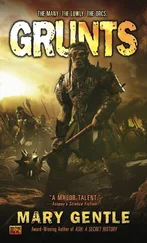Peck abandoned a career in solar physics, because he felt it was taking him too far away from the natural world. He and Vanessa share their home with more of that world than most. They keep as pets a tarantula (Henrietta) and a small community of Madagascar hissing cockroaches. Like William Baer, Peck is a man some might find eccentric, but those who know him even slightly can see that it all comes down to a generous and open heart.
Vanessa clears the dinner plates while I finish my wine. The children are doing homework in the living room. George sets a glass dessert dish in front of me. Chocolate pudding, my brain offers optimistically, but it’s not that. It’s raw liver.
“These are about one day old.” Peck points out a cluster of maggots, maybe twenty or thirty, feeding side by side, packed in close. They’re easy to miss, because all that can be seen of them is their tail ends. Insects take in oxygen through openings in the exoskeleton called spiracles. In the larvae, these are, specifically, anal spiracles. On top of its other charms, the maggot breathes through its ass. It is a handy evolutionary adaptation if, as Peck puts it, “you spend your whole day with your head buried in slimy dead flesh.” Compared to lungs and a diaphragm, it’s an inefficient system, which is one reason the Insecta class never evolved to be as large as Mammalia. Having several minutes ago viewed a fly under George Peck’s home microscope, I assure you that’s a good thing.
William Baer likened clusters of feeding maggots to litters of puppies. “So voracious are they in their struggle for food that they will stand upright on their heads with their tails in the air, as puppies do… around a basin of food where the basin is too small for the number of puppies.” Baer had dogs on the brain. To me, they look like a set of tiny accordion buttons being played by some ghost polka virtuoso. The important thing, especially for someone being treated with them, is that they don’t look like maggots. So if a patient peeked beneath the trademarked Monarch Labs LeFlap dual-layered maggot cage dressing, he would not be slammed with a squirming Halloween horror visual.
Peck transfers three outliers to the tip of my index finger. They rear up and wave their heads like happy Sesame Street puppets. Peck says they’re searching for food. Now two are lifting the third up above them. They remind me of jubilant teammates after a sporting victory.
Peck isn’t reading joy in the scene. “They do cannibalize,” he says gently.
Upon closer inspection, they are, yes, attacking— eating!— their clutch mate. They were away from the liver for maybe two minutes! The maggot lives to eat. That is what it does, all it does, for the four or so days before beginning the energy-intensive, deeply sci-fi project of rearranging itself into a fly.
Peck puts a maggot under the microscope he has set up on the kitchen table, so I can get a closer look at the mouthparts: the showpiece of maggot anatomy. They are rasping, curved scythe-like things. They’re the only piece of the maggot formed from chitin, hard and brown in contrast with the creature’s moist, pale, flexible self. Fortunately for maggot debridement therapy patients, the tissue deep inside a wound—dead or alive—has no sensory nerves; those are up in top layers of skin. Provided the Medical Maggots recommended “dosage”—5 to 8 maggots per square centimeter of wound surface—hasn’t been exceeded, there should be enough dead tissue to go around, and no ravenous maggot will shift its gaze to live skin.
“Those little mandibles,” Peck says as I look through the eyepiece, “can do what no surgeon or scalpel can do. No robotic laser can bend its light into a hidden crevice from an IED blast like that can. That is the master surgeon.” If you want to destroy every last bacterium and shred of dead tissue, a maggot is your man. He’s a small man, though, so it takes a while. A course of maggot debridement therapy—up to six rounds of fresh larvae—may take weeks. Whereas surgical debridement can be done in a matter of hours. And if a patient’s immune system is healthy, as a young soldier’s tends to be, it’s not necessary to get every last cell of bacteria and necrotic flesh.
But Peck never suggested that maggots be used for the initial debridement of a blast wound. For military personnel, maggots would come into play further down the road, should a recalcitrant infection set in—some antibiotic-resistant strain, perhaps something exotic and stubborn that lurked in the dirt that was blasted so deeply and voluminously into the wound. These complications set in often enough that Peck received military funding for a rodent study to measure the effectiveness of maggot debridement therapy for soil-infected IED wounds. The experimental protocol presented challenges. It required Peck’s team to surgically mimic, in a rat, the typical injuries caused by a bomb blast. To meet the requirements of the animal review board—and Peck’s own personal ethics—no part of the process could be painful to the rat. The nerves supplying feeling to that portion of the body had to be identified and severed.
Peck’s funding was not renewed, for reasons that are fairly easy to guess at. Modern hospital culture is technology-driven and forward-looking. To those unfamiliar with the studies and success rates, maggot therapy sounds primitive, anachronistic. Peck recalls presenting some promising preliminary findings to a roomful of colleagues and listening while a disapproving colonel talked about the thirty years of advancements he’d seen in his time at WRAIR. The man shook his head. “And we’re using maggots. ”
A 2012 survey of US Army physicians suggests that the colonel’s opinions are not those of the majority. While only 10 percent of those surveyed had prescribed maggot debridement therapy, 85 percent felt that having access to practitioners would be a good resource. Their reservations were mostly just practical: They didn’t know where to obtain the maggots or how to use them or what the billing code might be. [42] Medicare reimbursement code for maggots: CPT 99070.
In a smaller survey, practitioners voiced concerns that the medical facility they worked for wouldn’t allow maggots, and that patients would be likely to balk.
They are wrong about the patients. The surgeon who runs the Southern Arizona Limb Salvage Alliance, [43] I am inclined to like a man who creates—for a medical practice that specializes in bowl-shaped, moist red wounds—the acronym SALSA.
David Armstrong, has applied maggots to more than a thousand patients. “I can count on one hand the number of people who have refused,” he told me. The Medical Maggots FDA approval summary cited a “complaint and adverse event” rate of 1 percent, many of these occasioned by “late or lost” (or perhaps hurled into a Dumpster by the driver) FedEx shipments. The yuck factor of these wounds—and their resistance to more conventional treatment—well overrides the yuck factor of hosting live blowfly larvae. Also, Medical Maggots are less off-putting than you might imagine. Straight out of the vial, they’re the size of cupcake sprinkles. When they’re not eating each other alive, they’re kind of adorable. They move like inchworms, like something you might see humping along the pages of a children’s book.
“People take an interest in the cute little guys,” Armstrong said, quickly amending his statement with “…and gals.” You mean, I asked him, the way one might follow the progress of seedlings one has planted, or guppies one is raising? “Exactly,” he said. “And then, in turn, the progress of the healing going on. It’s hard to describe it, but the larvae draw people into the wound emotionally.” Medical Maggots patients, some anyway, are sufficiently positive and cavalier about their infestations that they go around wearing Monarch Labs t-shirts that proclaim, “Maggots on Board!”
Читать дальше












